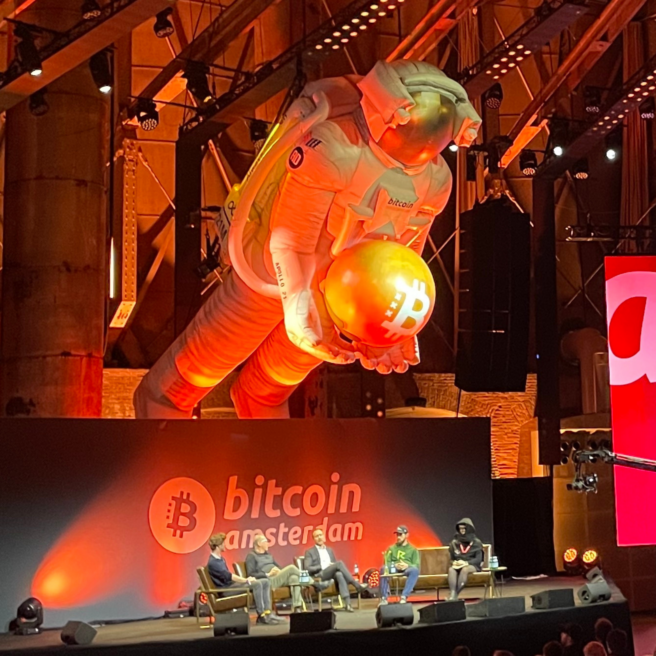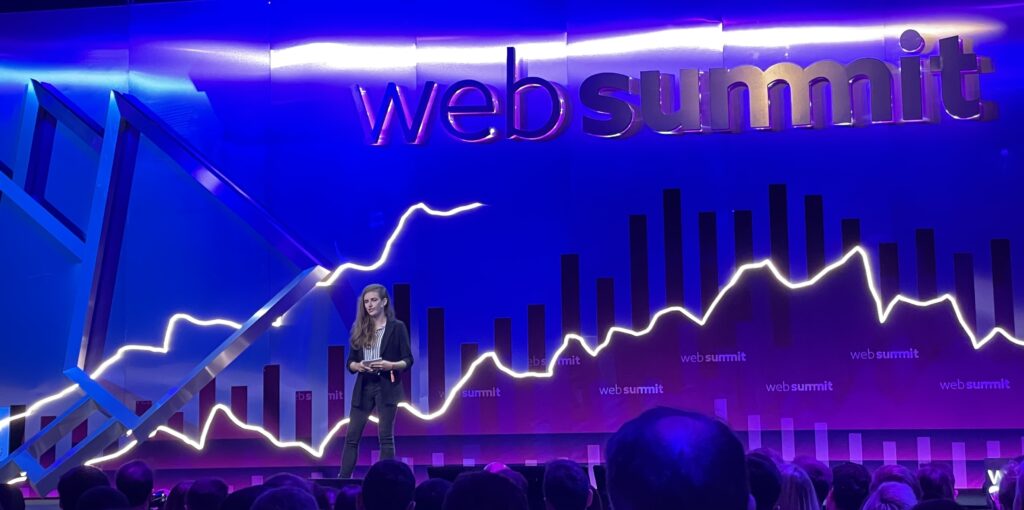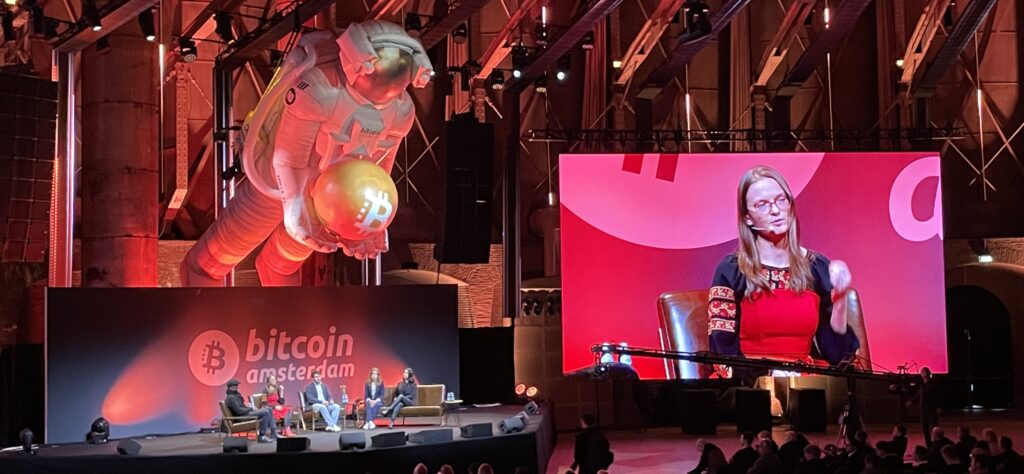

Future of Finance: Bitcoin Amsterdam & Web Summit Lisbon 2022
In the past months, our CEO, Rami Korhonen had the chance to visit two vastly different conferences addressing the future of finance: Bitcoin Amsterdam 2022 in September, and Web Summit 2022 in Lisbon in early November.
As one would expect, the Bitcoin Amsterdam 2022 conference’s speakers saw the best-case scenario for the future of finance as follows: The decentralized, open-source, inclusive, energy-backed, unstoppable, and leaderless Bitcoin network will become the monetary base layer of the world economy, either replacing or co-existing with the US dollar.

The Web Summit 2022 conference in Lisbon primarily focused on the so-called Web3 revolution instead of Bitcoin. The proponents of the Web3 movement envision a brave new world where today’s gatekeepers, such as the social media giants, no longer control and monetize our data. Instead, everyone will carry their data in a digital wallet, from where she/he can selectively share pieces of data when using the next generation of NFT-, metaverse-, Defi-, and other blockchain-based services.

It was interesting to see how these two conferences viewed the future of finance through the concepts of decentralization, time preference, and trade-offs. Let us dig in.
Decentralization
When Satoshi Nakamoto launched Bitcoin in 2008, she/he/them introduced the Proof-of-Work consensus mechanism. The thesis was that if bitcoin mining can be done by anyone and if the Bitcoin blockchain can be easily validated, it may become so widely adopted that no single entity can control it. Today Bitcoin is credibly decentralized, with over ten thousand nodes validating the blockchain and millions of bitcoin miners (ASICs) securing the bitcoin network worldwide.
The Bitcoin Amsterdam 2022 speakers and attendees mentioned some challenges in Bitcoin’s decentralization going forward. For example, only a handful of companies in the world manufacture competitive ASICs, and most mining happens through mining pools that could theoretically censor some transactions.
On the ASICs front, new credible producers, such as Intel, are entering the business, which should limit the power of the current top manufacturers, Whatsminer and Bitmain, over time. With mining pools, the risk of censorship is limited through two mechanisms: First, miners can stop using one mining pool can instantly switch to another pool with close to zero effort. Second, a new mining pool protocol, Stratum V2, is under development, which will reduce the mining pool’s current power in organizing Bitcoin transactions.
In contrast, “decentralization” in the Web3 community is primarily a marketing term, as most widespread projects have severe points of centralization. Ethereum blockchain has been rolled back due to the whims of its founding team, and smart contract services, such as Tornado Cash, have been censored on government request. In addition, running an Ethereum node is impossible for ordinary people due to its size and complexity.
Furthermore, Ethereum’s transition to the Proof of Stake consensus mechanism has sealed the deal on Ethereum becoming an increasingly centralized project. Already in September 2022 five largest staking pools controlled 64% of the staked ETH. Incredibly, the Ethereum developers have not yet even developed the possibility for stakers to unstake their ETH tokens. One cannot avoid thinking that locking up the supply of ETH serves the most significant owners of ETH exceptionally well.
From the perspective of decentralization, Bitcoin Amsterdam 2022 attendees and speakers were on much firmer footing than the Web3 proponents at Web Summit 2022.
Time Preference
Most bitcoiners I know view bitcoin as a long-term savings vehicle and patiently save and “hodl” their bitcoin through the extraordinary volatility of the market. The Bitcoin ethos is often symbolized by the concept of low-time preference, which signifies the individual’s willpower to defer instant gratification in exchange for higher rewards later down the line.
At Bitcoin Amsterdam 2022, when I spoke with the attendees and speakers, bitcoin prices were hardly ever mentioned. Instead, the emphasis was on understanding Bitcoin’s place within the broader economy, increasing Bitcoin’s resilience, and advocating for sovereign use of Bitcoin.
The importance of self-custody of one’s bitcoin became painfully relevant after the spectacular explosion of the popular Web3-promoting crypto exchange FTX in November 2022. When the remarkably blatant Ponzi scheme unraveled, hundreds of thousands lost their crypto wealth in the most unfortunate way.
People’s search for yield has been one of the reasons why people have kept their crypto tokens in 3rd party services, such as crypto exchanges. Searching for yield is a telltale sign of high-time preference, meaning that instead of patiently waiting for bitcoin’s purchasing power appreciation, many people want to reap more profits at once.
At Web Summit 2022, the focus was on token based Web3 projects. The cozy symbiosis of perceived blockchain innovation and fast-profit-seeking venture capital was clearly visible at the event. A welcome exception was the talk “Web3 Is Going Just Great” by Molly White, which sharply highlighted the downsides of the unhinged optimism often displayed by the proponents of Web3, metaverse, DeFi (Decentralized finance), and NFTs (Non fungible tokens).

Bitcoiners are often called close-minded and boring by the Web3 community, which prefers the faster-moving crypto, DeFi, and NFT projects, where smart contract-based innovation is supposed to change the world while rapidly enriching project founders and early investors.
After the blowups of Luna, Celcius, and FTX in 2022, the more disciplined long-term approach most bitcoiners embody has proven its power. The phrase popularized by the Bitcoin thinker and educator Matt Odell, “Stay humble and stack sats,” continues to serve bitcoiners well.
Trade-offs
At Bitcoin Amsterdam 2022, innovation primarily meant bringing the benefits of Bitcoin to more people in a more accessible and secure way. Startups like Fedi use the Federated Chaumian Mint (Fedimint) Technology to make Bitcoin more scalable while making the private use of bitcoin easier.
The idea is that a community, for example, a village or a church group, decides to create a circular economy based on Bitcoin. The community selects the more technologically savvy and trustworthy members to take charge of the Bitcoin-based mini-economy. While the total wealth of the community is managed by chosen people, no one has any information on the transactions between community members.
The Fedi case highlights the common emphasis of the Bitcoin community to explicitly talk about trade-offs. Yes, the Fedi concept includes risk (if the community selects five people to custody funds, and three collude to steal all the money, then money can be lost), but the benefit of bringing free tools for digital economy-building for the billions of underbanked people in the world far outweighs the risks.

Openly discussing trade-offs is not that popular among Web3, DeFi, NFT, and metaverse proponents. DeFi is hailed as the future of borderless finance without reminding us that billions have been lost due to bad smart contract coding. Smart contract platforms, such as Solana, promote speed and cost-efficiency while forgetting to mention that its blockchain is so centralized that it can go down for hours at any given moment. Furthermore, the DeFi ecosystem depends on stablecoins, such as Tether and USDC, with serious centralization vulnerabilities.
Most Web3 projects are VC-backed, pre-mined, and led by founder teams, which creates a myriad of conflicting interests between the project’s insiders and the broader community of token-holders. For example, VCs have the incentive to get in early for cheap and then dump most of their token holdings when the promotional fever pitch occurs, with no connection to the actual utility of the project, which in most cases is zero. At Web Summit 2022, the promotional aspect of altcoins was vividly visible, with enormous billboard ads aimed to catch the attention of conference attendees.
If non-Bitcoin blockchain projects want to gain sustainable credibility, they should openly show all the trade-offs of their solutions. The reason that they mostly do not might be that the trade-offs often outweigh the promoted benefits.
Towards Bitcoin-Centric Future
At Oivan we’ve developed the Hatch white-label bitcoin savings solution, which allows financial service providers to launch bitcoin savings features with close to zero coding. We’ve used our nine years of experience in developing bitcoin broker services to make Hatch a highly efficient platform, which can be used as a module inside a fintech app, or as a standalone application.

Our company, Oivan, also has experience from Hyperledger Fabric based tokenization projects and has built the TokenIT product as a general asset tokenization platform. After continuously learning about Bitcoin and blockchain technology since 2017, I’ve personally become increasingly confident on Bitcoin’s long-term civilization-upgrading potential, while becoming quite skeptical on most non-Bitcoin uses of blockchain technology.
A few days ago, I was coaching a young entrepreneur with a health & wellness-related business idea with a heavy NFT/crypto/DeFi angle; after talking about the trade-offs related to the concept, I got him to start looking into Lightning Network-based Bitcoin features (play to earn sats) instead of NFTs and proprietary cryptos. Let us see what he decides, but it felt great to give Bitcoin-centric advice to this emerging entrepreneurial talent.
Would you be interested in knowing more about our Blockchain service? Please feel free to contact me, Oivan CEO Rami Korhonen, if you would like more information.
Rami Korhonen
rami.korhonen@oivan.com
+358 40 730 7813